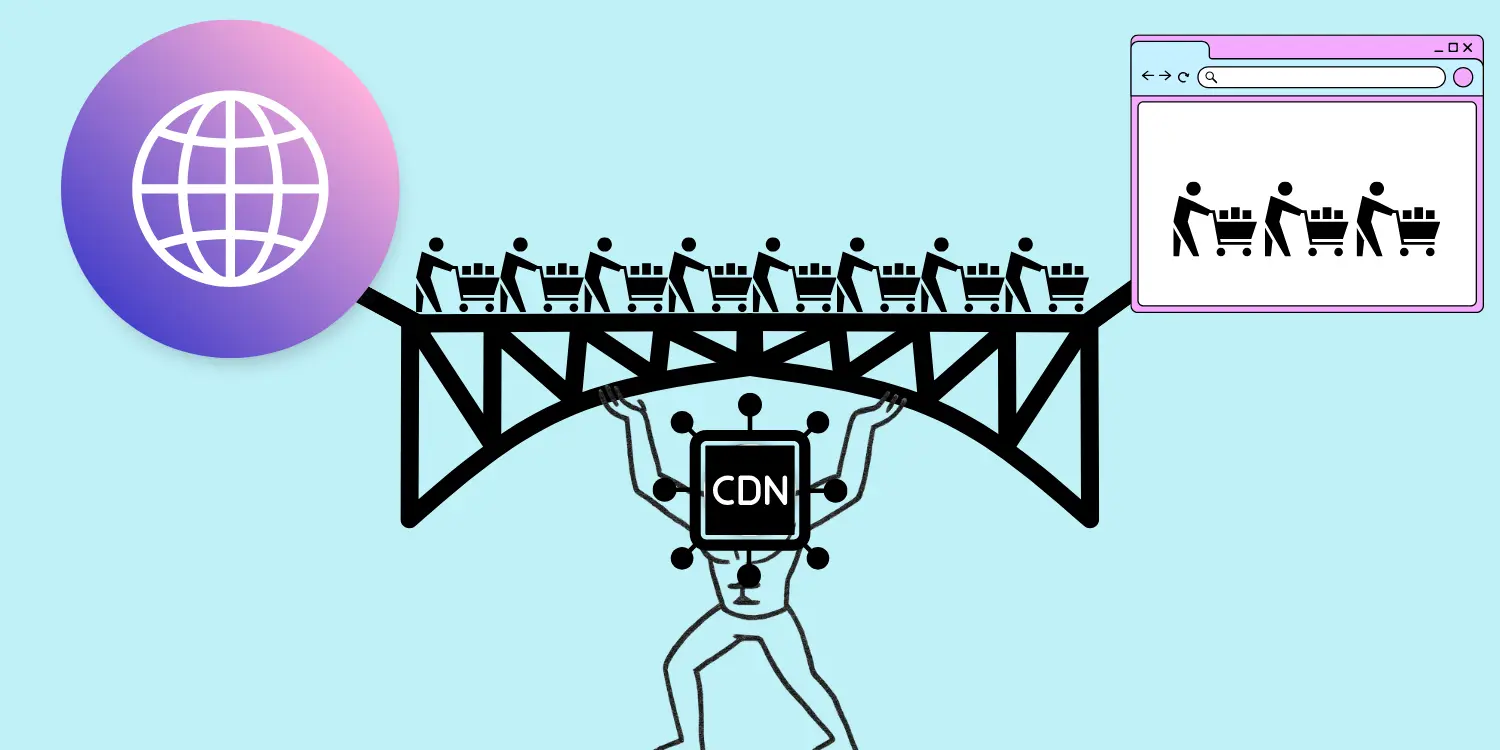Anybody have bandwidth? Maybe, enhanced LCP load times? Or, a CDN that actually works? Maybe, you have all three? During holiday seasons and times of the year when peak volume can send latency times soaring, you need methods to keep your customer experience UX smooth and sharp.
Customer experience (CX) is forged in high-pressure moments such as those that surround seasonal trends and high-traffic e-commerce holidays. These include those peak-volume surges that make or break your domain and your brand's presence on the web as a functional D2C brand. Whether it’s Black Friday for e-commerce, or a flash sale for a newly launched product, or simply a viral product launch, your customers don’t care if your queue has doubled.
Customers expect frictionless, personalized service, instantly.
But while volume surges are predictable (and, frankly, unavoidable), what happens next is entirely within your operational control. According to recent studies, 90% of customers expect immediate responses even during peak periods, and 73% will leave for competitors after a single bad customer experience.
But, don't zero in on just the negatives, brands that deliver streamlined experiences under pressure can see 4 to 10 percent increases in customer spend. By deciding how your e-commerce website will handle the stress of traffic in advance, you'll be able to shape your infrastructure to scale efficiently and maintain site performance.
How do the best teams keep CX steady when tickets flood in from every direction? Here’s a tactical blueprint built for operators who want zero excuses, and rock-solid outcomes.
[cta-btn title="Build Your Brand And Become A Member" link="/membership-pricing"]
Laying the Foundation: Prepping for Volume Surges
Operational resilience is established well in advance of disruption. Leading CX teams adopt a proactive approach, preparing months ahead and framing peak seasons not only as high-risk periods but also as strategic opportunities for performance optimization.
Workforce Planning Essentials:
- Early Recruitment: Don’t scramble last-minute for seasonal help. Start hiring well in advance—identify roles that require specific skills (like licensed support or tech fluency).
- Flexible Staffing: Partner with BPOs or gig platforms to access scalable, global pools so you can flex your headcount up or down without chaos.
- Cross-Training: Pre-empt bottlenecks by cross-training reps across several channels (chat, phone, email). That way, no queue gets out of hand while another idles.
Tech Stack Readiness:
- AI Training: Deploy training tools that accelerate onboarding so seasonal staff hit their stride, fast.
- Knowledge Management: Maintain a clean, accessible help center. If agents can’t find answers, neither can your customers.
- Automation Testing: Run “storm drills”—simulate double-normal volumes to expose integration gaps or broken workflows before real customers are waiting.
Automation That Doesn’t Lose the Human Touch
Even at max volume, efficiency can’t be an excuse for robotic interactions. Smart automation should clear low-grade tickets so agents focus on nuance—without ever letting customers feel like a number.
Balancing Self-Service and Empathy
- Diagnostic Self-Service Flows: Interactive FAQs or chatbots should handle routine queries—brands report that 30–40% of peak tickets disappear with a well-designed self-help pathway.
- Strategic Intent Deflection: Analyze your top customer intents, then build decision trees or IVRs to efficiently redirect repeat requests. Not every surge ticket needs human touch.
- Instant Knowledge Surfaces: Empower agents with one-pagers—like a first-responder’s go-bag—containing macros, refund protocols, and escalation trees. In a flood, seconds matter.
Agent-Enhancing Tools
- Real-Time Coaching: Layer in AI support that nudges reps with recommended responses based on prior successful outcomes.
- Oxygen-Mask Meters: Monitor individual queue sizes and pause new assignments once agents hit a defined red zone. Simple throttling prevents burnout and protects CSAT.
The Power of Proactive, Data-Led Customer Experience Frameworks
Proactivity is essential during peak periods; it is an expectation, not a luxury. When demand is high, customers recognize which teams take the initiative and which fall behind. One way top operators stay ahead is by knowing how to effectively measure the ROI of tests and optimizations, ensuring they’re investing in improvements that actually move the needle before peak season arrives.
Data-Driven Anticipation:
- Analyze Last Season’s Patterns: Use conversation intelligence and dashboards to forecast ticket surges, identify recurring bottlenecks, and anticipate resource allocation needs.
- Real-Time Triage by Emotional Urgency: Route “furious” or high-emotion cases (flagged by keywords, caps, or emoji) to the most empathetic agents—fast empathy beats record handle times every time.
- Micro-Updates, Not Silence: Like airlines, push automated pings to customers every 30 minutes if their case slips. Small updates buy loyalty during unavoidable delays.
Operational E-Commerce Playbooks Built for the Real World CX
No playbook survives contact with volume unless it’s battle-tested and actionable. Here’s how seasoned CX leaders keep queues in check without sacrificing brand aesthetic or feel.
[single-inline-tool]
Top 10 Tactics for Keeping CX Rock-Solid in High Volume
- Agent “Go-Bag”: One-page cheatsheet of scripts, policies, and escalation routes for lightning-fast responses.
- Pre-Season “Storm Drills”: Double-volume dummy queues to stress-test workflows and flag automation failures before they go live.
- Self-Service as Airway Management: Decision trees or chatbots that let customers solve simple issues instantly.
- Military-Style Squad Rotation: Rotate mini-teams between channels every 90–120 minutes to avoid fatigue and knowledge drop-off.
- Emotional Triage: Immediate routing of crisis cases to veteran agents—using simple triggers like urgency keywords.
- Oxygen-Mask Assignment Throttling: Dashboard-driven throttles to pause new tasks for overloaded reps.
- Frequent Status Pings: Automated, short updates to waiting customers to remedy radio silence.
- Knowledge Scavenger Hunt: Off-season competitions among agents to hunt for outdated or missing help content.
- Courtesy-Handshake Macro: Insert a personalized thank-you GIF or video at resolution—quick win that slashes repeat tickets.
- Post-Peak Forensic Retro: Host honest post-mortems, anonymize findings, and fix the cracks before next season hits.
Sustaining Team Energy and Managing Seasonal Burnout From High Web Traffic
Customer experience begins with the strength of the team. During periods of high web traffic, rising ticket volumes significantly increase the risk of burnout. Long-term throughput and service quality depend directly on the sustainability of the employee experience.
Preventing Burnout:
- Rotation and Recovery: Swap teams between channels and tasks; schedule true downtime after tough shifts.
- Recognition Programs: Celebrate top performers, share real peak-week success stories to reinforce impact.
- Mental Health Support: Provide access to counseling or mental wellness tools—if agents aren’t breathing, neither is your team’s CX.
Agent Feedback Loops:
- Two-Way Communication: Run quick feedback sessions with agents to flag what tools or workflows break under load. Insights compound over cycles.
Cementing a Culture of Continuous CX Improvement
Peak volumes are a recurring reality, best approached as part of an ongoing cycle rather than a one-off crisis. The top CX teams document challenges, address process gaps, and translate each peak into structural improvements that strengthen long-term performance. A disciplined approach, such as a team that understands effective A/B split testing, ensures improvements are tested and validated before the next surge.
Post-Peak/Volume Surge Analysis:
- Mishap Boards: Like aviation teams, anonymize queue analytics, escalations, and breakdowns. Circulate learnings to the entire org.
- Process Updates: Codify what worked (and what didn’t) in a living playbook accessible to every level.
- Infrastructure Investment: Don’t just patch leaks—increase baseline headcount, knowledge assets, and automation sophistication each cycle.
Transforming Immense Web Traffic into Your Brand Advantage
Managing traffic surges is not only about maintaining operations; it can become a lasting competitive advantage when others struggle. Delivering a consistent customer experience during peak seasons garners higher spending and transforms seasonal buyers into long-term advocates.
Your busiest days can serve as proof points that strengthen brand loyalty and attract future customers. The real question is not whether the next surge will come, but whether your team is prepared to convert disruption into customer obsession. With the right foundation, peak periods become an opportunity to lead rather than a risk to endure.
[inline-cta title="Discover More With Our Resources" link="/resources"]
Frequently Asked Questions for E-Commerce Customer Experience During Peak Volume
Why Does Peak-Volume Customer Experience Matter For E-Commerce?
According to recent studies, 90% of customers expect immediate responses even during peak periods, and 73% will leave for competitors after a single bad customer experience. Brands that deliver streamlined experiences under pressure can see 4 to 10 percent increases in customer spend.
How Should Teams Prepare For Peak Volume Seasons?
Start hiring well in advance, partner with BPOs or gig platforms to access scalable global pools, and cross-train reps across several channels like chat, phone, and email. Run storm drills by simulating double-normal volumes to expose integration gaps or broken workflows before real customers are waiting.
How Should Automation Support Customer Experience During Traffic Spikes?
Interactive FAQs or chatbots should handle routine queries as brands report that 30–40% of peak tickets disappear with a well-designed self-help pathway. Smart automation should clear low-grade tickets so agents focus on nuance without ever letting customers feel like a number.
How Can You Be Proactive During Volume Surges?
Use conversation intelligence and dashboards to forecast ticket surges, identify recurring bottlenecks, and anticipate resource allocation needs. Route furious or high-emotion cases flagged by keywords, caps, or emoji to the most empathetic agents, and push automated pings to customers every 30 minutes if their case slips.





